中国文化通览13解读
英汉对照,纵览中华文化——《中国文化通览》评介

作者: 艾斌
作者机构: 《中国外语》
出版物刊名: 中国外语
页码: 107-109页
主题词: 中国文化精神;英汉对照;中华文化;人文精神;英文表达;英语专业学生;文化知识;大学生;思想文化;相关知识
摘要: 《中国文化通览》(简称《通览》,高等教育出版社,2006年)是一部博中见细、细中蕴情的概述性英汉对照文化读本。
读者可以从中了解中国浩瀚的文化知识,培养自觉人文精神。
该书以英文开篇,辅以中文做参照,英汉两大部分相对独立并大致吻合,英文部分起到帮助使用者学习相关知识英文表达的作用,中文部分则可以帮。
中国文化通览

先秦文化先秦是中国文化的发展由萌芽到初具体系规模的时期。
中国文化的起源是多元的,有人喻之为“满天星斗”,但主要源头有三,一是东夷文化,二是西夏文化,三是南蛮文化。
东夷文化起源于黄河下游的今山东、苏北地区,东夷族的著名领袖有太昊、少昊、蚩尤、帝喾、舜等。
西夏文化发源于黄河中上游的今陕甘晋南地区,著名领袖有炎帝、黄帝、颛顼、尧等。
南蛮文化起源于江淮流域,领袖有盘瓠等。
东夷和西夏二族的发展是沿黄河对进,长期的又战又和的格局最终促成了民族间的融合,形成了华夏族的前身。
夷、夏文明的冲撞为中国古代文化的形成奠定了基础。
华夏集团又南下征服了南蛮集团,形成了中华民族的雏形。
他们远祧炎帝、黄帝二祖,所以中华民族又被称为“炎黄子孙”。
夏、商、西周史称“三代”,“三代”是统一的、宗法性的王权专制国家形成发展的时期。
在这一时期,“溥天之下,莫非王土,率土之滨,莫非王臣”的大一统观念逐渐形成,宗法性质的礼乐文化成型,并对以后中国文化的发展打下了深刻的印记,中国被称为“礼仪之邦”。
所谓“礼仪”文化,指通过繁复的、无所不在的礼节规定,将每个人的社会角色意识加以强化,明确其应该享有的权利和应该承担的义务。
三代的物质文明成果是青铜文化,精美绝伦的青铜器成为世界古代文明的瑰宝。
商代的甲骨文、西周的青铜铭文已经是相当成熟的文字,构字方法已有了象形、指事、会意和形声,并出现了由这些文字记录而成的文献。
春秋、战国是中国早期文化大发展并形成初步体系和规模的时期。
虽然在这一时期政治上呈现出列国争霸兼并的割据状态,但共同的民族文化意识将这些割据战争定性为民族的统一战争,战争成为中国走上新的统一的途径。
在战争中,更多的部族国家参与进来,促进了更大范围的文化融合,从而为秦汉统一的封建大帝国的建立打下了基础。
与政治上的割据状态相适应的是思想领域“百家争鸣”的局面。
春秋末年孔子首创私学,打破了“学在官府”的学术垄断,建立了儒家学派。
孔子是中国文化继往开来的伟大人物,他整理了夏商周“三代”的文化成果“五经”,即《诗》、《书》、《礼》、《易》、《春秋》,又创立了“礼”和“仁”结合的思想体系,开辟了中国思想文化的新局面。
中国通史第十三集观后感北宋的政治与文化

中国通史第十三集观后感北宋的政治与文化《中国通史第十三集观后感:北宋的政治与文化》中国历史悠久而辉煌,其中宋代是一个极具代表性的时期,特别是北宋时期的政治与文化,更是展现了中国古代社会的繁荣与变迁。
观看《中国通史第十三集》,我对北宋的政治格局和文化传统有了更加深入的认识。
北宋是中国历史上的一个重要时期,其政治制度和文化传统都具有独特的特点。
首先,北宋政治秉持了一种高度中央集权的体制,这种体制对于国家运行和社会秩序的维护起到了重要的作用。
在这样的体制下,官僚制度得以健全发展,中央政府能够有效地管理全国各地的事务。
同时,北宋政权对于科举制度的重视也使得社会上的人才更容易脱颖而出,为国家的发展做出了巨大的贡献。
其次,北宋的政治制度也存在一些问题。
在中央集权的体制下,大臣和皇帝的权力过于集中,导致了整个国家政治的不稳定。
加之时局的变幻莫测,使得北宋政权时常面临内患和外患的威胁。
然而,尽管如此,北宋政权依然能够保持着相对的稳定,并在文化上取得了一定的成就。
北宋的文化传统是中国古代文化的重要组成部分,它充分展示了中国古代文化的博大精深。
北宋时期,文人墨客林立,他们以文学、绘画、音乐等艺术形式表现了自己的情感和思想。
其中,诗词创作得到了高度的重视和发展,成为了当时文化精英们流行的一种表达方式。
北宋文化的特点之一是它强调了“词人”的作用,这些词人们才华横溢、文思敏捷,他们所创作的词作成为了当时文化的重要标志。
除了词人,北宋的绘画艺术也达到了一个高峰。
北宋时期出现了很多杰出的画家,他们以山水画、花鸟画等形式为后人留下了众多珍贵的艺术作品。
这些作品不仅展现了画家对于自然环境的细腻观察和描绘,还体现了北宋社会的文化风貌和审美趣味。
同时,北宋还在书法、舞蹈、戏曲等领域取得了许多成就,使其文化成为了当时东亚地区的璀璨之光。
然而,北宋文化也存在一些问题。
由于政治形势的变动和社会问题的出现,北宋文化在某种程度上受到了一定的束缚。
中国文化通览课程心得
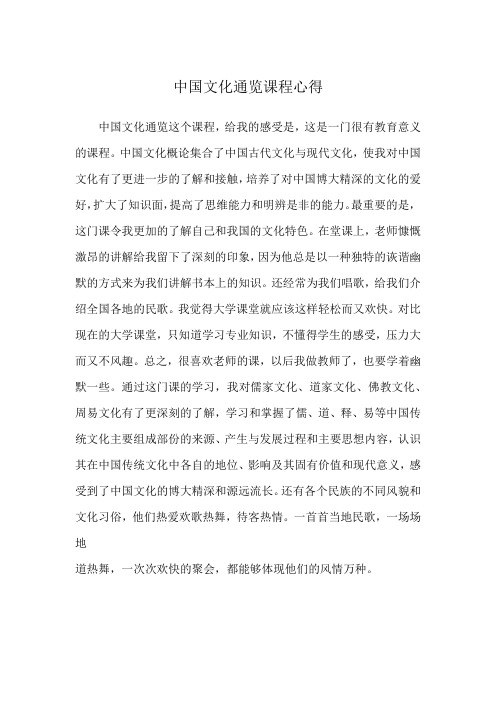
中国文化通览课程心得
中国文化通览这个课程,给我的感受是,这是一门很有教育意义的课程。
中国文化概论集合了中国古代文化与现代文化,使我对中国文化有了更进一步的了解和接触,培养了对中国博大精深的文化的爱好,扩大了知识面,提高了思维能力和明辨是非的能力。
最重要的是,这门课令我更加的了解自己和我国的文化特色。
在堂课上,老师慷慨激昂的讲解给我留下了深刻的印象,因为他总是以一种独特的诙谐幽默的方式来为我们讲解书本上的知识。
还经常为我们唱歌,给我们介绍全国各地的民歌。
我觉得大学课堂就应该这样轻松而又欢快。
对比现在的大学课堂,只知道学习专业知识,不懂得学生的感受,压力大而又不风趣。
总之,很喜欢老师的课,以后我做教师了,也要学着幽默一些。
通过这门课的学习,我对儒家文化、道家文化、佛教文化、周易文化有了更深刻的了解,学习和掌握了儒、道、释、易等中国传统文化主要组成部份的来源、产生与发展过程和主要思想内容,认识其在中国传统文化中各自的地位、影响及其固有价值和现代意义,感受到了中国文化的博大精深和源远流长。
还有各个民族的不同风貌和文化习俗,他们热爱欢歌热舞,待客热情。
一首首当地民歌,一场场地
道热舞,一次次欢快的聚会,都能够体现他们的风情万种。
(完整)中国文化通览 (10)
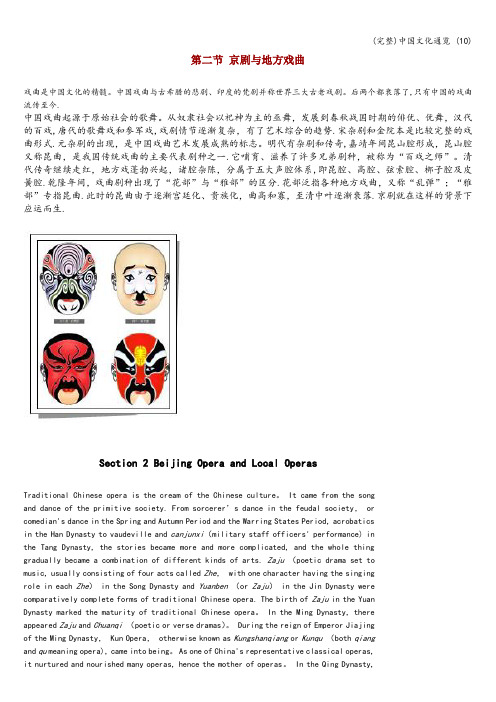
第二节京剧与地方戏曲戏曲是中国文化的精髓。
中国戏曲与古希腊的悲剧、印度的梵剧并称世界三大古老戏剧。
后两个都衰落了,只有中国的戏曲流传至今.中国戏曲起源于原始社会的歌舞。
从奴隶社会以祀神为主的巫舞,发展到春秋战国时期的俳优、优舞,汉代的百戏,唐代的歌舞戏和参军戏,戏剧情节逐渐复杂,有了艺术综合的趋势.宋杂剧和金院本是比较完整的戏曲形式.元杂剧的出现,是中国戏曲艺术发展成熟的标志。
明代有杂剧和传奇,嘉靖年间昆山腔形成,昆山腔又称昆曲,是我国传统戏曲的主要代表剧种之一.它哺育、滋养了许多兄弟剧种,被称为“百戏之师”。
清代传奇继续走红,地方戏蓬勃兴起,诸腔杂陈,分属于五大声腔体系,即昆腔、高腔、弦索腔、梆子腔及皮簧腔.乾隆年间,戏曲剧种出现了“花部”与“雅部”的区分.花部泛指各种地方戏曲,又称“乱弹”;“雅部”专指昆曲.此时的昆曲由于逐渐宫廷化、贵族化,曲高和寡,至清中叶逐渐衰落.京剧就在这样的背景下应运而生.Section 2 Beijing Opera and Local OperasTraditional Chinese opera is the cream of the Chinese culture。
It came from the songand dance of the primitive society. From sorcerer’s dance in the feudal society, orcomedian's dance in the Spring and Autumn Period and the Warring States Period, acrobaticsin the Han Dynasty to vaudeville and canjunxi(military staff officers' performance) inthe Tang Dynasty, the stories became more and more complicated, and the whole thinggradually became a combination of different kinds of arts. Zaju(poetic drama set tomusic, usually consisting of four acts called Zhe, with one character having the singingrole in each Zhe) in the Song Dynasty and Yuanben(or Zaju) in the Jin Dynasty werecomparatively complete forms of traditional Chinese opera. The birth of Zaju in the YuanDynasty marked the maturity of traditional Chinese opera。
中国文化通览(A班)An Introduction to Chinese Culuture

第六节
中西文化的比较
一、历史渊源:中华文化历时五千年,渊源一 贯。西方文 化来源有三:希腊文化、罗马文化和希伯来文化,渊源 杂。 二、民族性格:中国人天人合一,崇尚自然,内向、中庸 性格。 西方人种杂,变迁多,好与自认斗争,性格外向,个性 鲜明。
三、经济:主静、轻商,缺乏扩张心理。西方文化商业发 展较早且块,重商主义影响较大。 四、伦理道德: 中华文化的伦理基础是父子,重孝、悌。 西方文化重视的不是自我修养,而是发挥个性,没有忠 孝的伦理观念,人人平等。 五、政治:崇尚贤人政治,讲王道,人治。古希腊即有法 制传统。
二、文化的结构与分类
从时间角度上,文化可以分为原始文化(primitive )古代 文化(ancient) 、近代文化(modern)、现代文化 (contemporary ) 从空间角度上,可以分为东方文化(oriental) 、西方文化 (western)、海洋文化(oceanic) 、大陆文化 (continental ) 从社会层面上,可以分为贵族文化(aristocratic )、平民文化 (civilian )、官方文化(official )、民间文化 (folk)
四、近代中国文化的转型与走向(The Transformation and Tendency of Chinese Modern Culture) 第一次转型发生于洋务运动(Westernization Movement 至五四新文化运动(May 4th New Culture Movement)期 间 第二次转型发生于五四运动以后到改革开放(the reform and open policy in the late 1970s) 之前,分为两个 阶段。第一阶段是五四到新中国成立。第二阶段是新中 国成立后的文化实践。 第三次文化转型是在痛苦的文化反思的基础上进行的。
《中国文化通览》教案
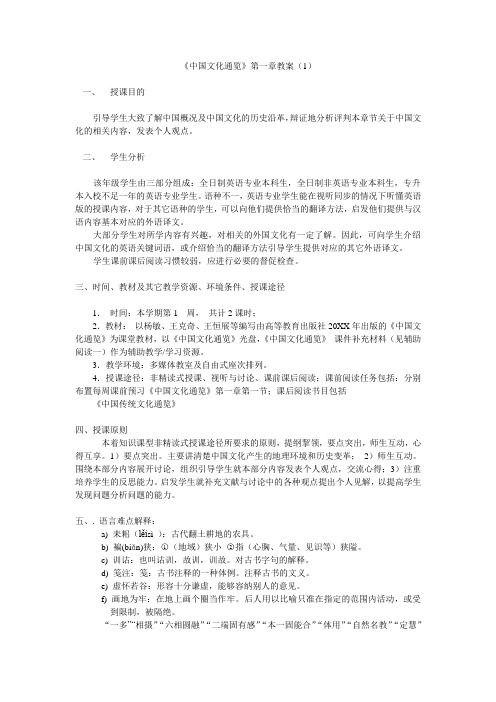
《中国文化通览》第一章教案(1)一、授课目的引导学生大致了解中国概况及中国文化的历史沿革,辩证地分析评判本章节关于中国文化的相关内容,发表个人观点。
二、学生分析该年级学生由三部分组成:全日制英语专业本科生,全日制非英语专业本科生,专升本入校不足一年的英语专业学生。
语种不一,英语专业学生能在视听同步的情况下听懂英语版的授课内容,对于其它语种的学生,可以向他们提供恰当的翻译方法,启发他们提供与汉语内容基本对应的外语译文。
大部分学生对所学内容有兴趣,对相关的外国文化有一定了解。
因此,可向学生介绍中国文化的英语关键词语,或介绍恰当的翻译方法引导学生提供对应的其它外语译文。
学生课前课后阅读习惯较弱,应进行必要的督促检查。
三、时间、教材及其它教学资源、环境条件、授课途径1.时间:本学期第1 周,共计2课时;2.教材:以杨敏、王克奇、王恒展等编写由高等教育出版社20XX年出版的《中国文化通览》为课堂教材,以《中国文化通览》光盘,《中国文化通览》课件补充材料(见辅助阅读一)作为辅助教学/学习资源。
3.教学环境:多媒体教室及自由式座次排列。
4.授课途径:非精读式授课、视听与讨论、课前课后阅读;课前阅读任务包括:分别布置每周课前预习《中国文化通览》第一章第一节;课后阅读书目包括《中国传统文化通览》四、授课原则本着知识课型非精读式授课途径所要求的原则,提纲挈领,要点突出,师生互动,心得互享。
1)要点突出。
主要讲清楚中国文化产生的地理环境和历史变革;2)师生互动。
围绕本部分内容展开讨论,组织引导学生就本部分内容发表个人观点,交流心得;3)注重培养学生的反思能力。
启发学生就补充文献与讨论中的各种观点提出个人见解,以提高学生发现问题分析问题的能力。
五、. 语言难点解释:a) 耒耜(lěi sì):古代翻土耕地的农具。
b) 褊(biǎn)狭:○1(地域)狭小○2指(心胸、气量、见识等)狭隘。
c) 训诂:也叫诂训,故训,训故。
中国文化通览(6)

Chapter ThreeEminent personnel in the history of the Chinese culture第一节古代文化名人老子老子姓李,名耳,字聃,楚国苦县(今河南鹿邑县)人,生活时代约和孔子同时或略早,道家学派的创始人。
曾做过周朝守藏史,后退隐,作《老子》五千言,思想的核心是“道”。
他把天地未生之前的浑沌状态称为“道”,道是天地之根,天下之母,万物的本源,“道生一,一生二,二生三,三生万物。
”道周而复始地运动着,其基本运动形式是“反者道之动”,即矛盾的对立面各向其相反的方向转化。
以“道”为理论基础,在人生观上,老子贵无,尚柔,“天下莫柔于水,而攻坚强者莫之能胜”;主静,“致虚极,守静笃”;要对心灵“涤除玄鉴”,从而返自观照内心的本明;要“见素抱朴,少私寡欲”,保持一颗赤子之心。
老子执著于个体生命的自我保全,特别是精神状态的自我调谐。
在政治观上,老子主张无为而治,“我无为而民自化,我好静而民自正,我无事而民自富,我无欲而民自朴”,“为者败之,知者失之。
”反对战争,认为“兵者,不祥之器,不得已而用之。
”老子的理想社会是自然原始、封闭隔绝的“小国寡民”社会。
在天道观上,老子认为天是有意志的,天意决定一切。
天意向善,同情弱者,损有余而补不足,“高者抑之,下者举之”。
总之,老子清静无为的思想是时代的产物,在列国纷争的春秋战国时期,是对现实的一种澄清与批判,反映了当时一部分知识分子对未来社会走向与治国方式的一种探索。
Lao ZiFamous Chinese philosopher and founder of Taoism, Lao Zi (also known as Lao Tzu, Lao Tse or Lao Tze) was born at Ku Prefecture (today’s Luyi County of Henan province) in the later years of the Spring and Autumn Period. His real name was Li Er and his courtesy name was Dan. Lao Zi was an older contemporary of Confucius and once worked as an archivist in the imperial library of the Zhou Dynasty before he retired from public life.It is widely believed that he was the author of the Taoist scripture Lao Zi(also known as Tao Te Ching, or Dao De Jing, roughly translated as Book of the Way and Its Virtue). Slightly more than 5 000 characters, this book is considered as one of the most influential texts on Chinese philosophy and religion. The core of Lao Zi’s thought is “Tao” (the Way), by which he refered to the condition of the universe before the creation of the heaven and the earth. Therefore, it is from Tao that all the elements of the universe are derived. Reversal enables Tao to have a circular movement, that is, when thedevelopment of anything brings it to one extreme, a reversal to the other extreme takes place. Using Tao as the point of departure of his philosophy, Lao Zi believed that soft and weak overcome hard and strong (“Of all things yielding and weak in the world, none is more so than water. But for attacking what is unyielding and strong, nothing is superior to it.”). He upheld the idea of stillness and tranquility (“Attain utmost vacuity, hold fast to quietude.”) and suggested that only through “cleansing and purifying the distracting thoughts”can one understand one’s true self. For him, it was more important to “see the simplicity, to realize one’s true nature, to cast off selfishness, and to temper desire”. Lao Zi attached importance to the withdrawal in oneself, especially through the cultivation and regulation of mentality with one’s own efforts. Politically, Lao Zi advocated ruling by non-action or inaction (“wu wei”), on which he wrote that “I take no action and people are reformed. I enjoy peace and people become honest. I do nothing and people become rich. I have no desires and people return to the good and simple life.” and “If you try to change it (the universe), you will ruin it. If you try to hold it, you will lose it.” Lao Zi also took an anti-war stance: “Weapons are the tools of fear; a decent man will avoid them, except in the direst necessity.” The idealistic state in his description is naturalistic, even primitive and in isolation: “Let your community be small, with only a few people.” Lao Zi believed that the force behind the motion of the universe is overwhelming: “What is higher is pulled down, and what is lower is raised up; what is taller is shortened, and what is thinner is broadened; Nature’s motion decreases those who have more than they need and increases those who need more than they have.” Lao Zi’s pursuit of vacuity and action through non-action echoes the reality of his time, a period torn by ceaseless wars among states. His philosophy reflects the exploration of an intellectual for the ultimate solution of the social order and individual freedom.庄子庄子(约前369—前286),名周,宋国蒙(今河南商丘东北)人,是继老子之后道家学派的代表人物。
中国文化通览(1)
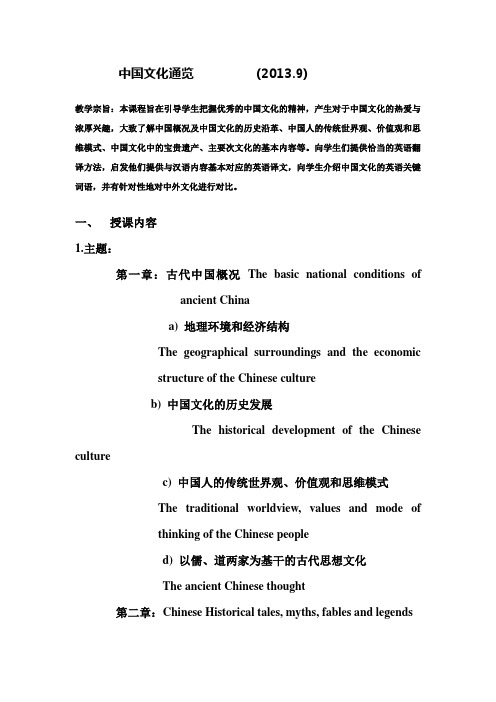
中国文化通览(2013.9)教学宗旨:本课程旨在引导学生把握优秀的中国文化的精神,产生对于中国文化的热爱与浓厚兴趣,大致了解中国概况及中国文化的历史沿革、中国人的传统世界观、价值观和思维模式、中国文化中的宝贵遗产、主要次文化的基本内容等。
向学生们提供恰当的英语翻译方法,启发他们提供与汉语内容基本对应的英语译文,向学生介绍中国文化的英语关键词语,并有针对性地对中外文化进行对比。
一、授课内容1.主题:第一章:古代中国概况The basic national conditions ofancient Chinaa) 地理环境和经济结构The geographical surroundings and the economicstructure of the Chinese cultureb) 中国文化的历史发展The historical development of the Chinese culturec) 中国人的传统世界观、价值观和思维模式The traditional worldview, values and mode ofthinking of the Chinese peopled) 以儒、道两家为基干的古代思想文化The ancient Chinese thought第二章:Chinese Historical tales, myths, fables and legendsa) 历史故事Chinese historical talesb) 神话Mythsc) 寓言Fablesd)民间传说Folklores第三章:中国文化名人Eminent personnel in the history of the Chinese culturea) 古代文化名人Eminent personnel in the ancient timesb)近现代文化名人Eminent personnel in the modern times第四章:中国名篇名著famous Chinese literary worksa) 中国文化名著Masterpiecesb)中国文化名篇Well-known literary pieces第五章:中国文化瑰宝Gems of the Chinese Culturea)四书五经The Four Books and The Five Classicsb)京剧与地方戏曲Beijing Opera and local operasc)中国书画Chinese painting and calligraphyd)生活中的文化符号Cultural tokens in daily life第六章:中国民间艺术与竞技Folk arts and sportsa)民间工艺Folk handicraftb)民间游艺Folk performance and Entertainmentc)民间竞技Folk sports第七章:中国风土人情Chinese folk culturesa) 饮食文化The dietetic cultureb) 酒文化The wine culturec) 茶文化The tea cultured) 姓氏文化The name culturee) 节日文化The festival culture第八章:中国地理文化Chinese geographical culturea) 古城古迹Ancient cities and historical sitesb) 景点景观Famous scenic spotsc) 名山Famous Mountainsd)河流湖泊Famous rivers and lakes第九章:中国建筑与园林Chinese architecture and gardeninga) 传统建筑风格Ancient architectural stylesb)著名传统建筑Famous ancient constructionsc) 园林及其特色Chinese gardeningI. Translate the following terms or expressions:1.四大发明2. 儒家文化3.春联4.针灸5. 草书6.贵妃醉酒7. 兵马俑8. 四大古典名著9. 四大菜系10. 脸谱1. The compass, the gunpowder, the art of paper-making and the movable type printing2.Confucianism3. Chinese (spring) couplets4. acupuncture 5 cursive script 6.The Drunken Concubine 7. The terra cotta armies and horses 8.《西游记》Pilgrimage to the West; Journey to the West 《三国演义》The Romance of the Three Kingdoms 《红楼梦》A Dream in Red Mansions (The Story of the Stone) 《水浒传》Heroes of the Marshes; Water Margins 9. Four major groups (styles)of Chinese Cuisine (homework) 10. Facial paintings (facial masks?)II. When Shakespeare was busy producing his works, one of his contemporaries in China was also writing his later well-known work, who was he? What work was it? (ppt sy)III. Confucius has been a unique symbolic figure of Chinese culture, do you know much about him, e.g. the years (dates) of his birth and death? Why do Chinese people believe that 73 84 are ominous(esp. for old people)?中国文化通览中国文化是一个历史的范畴,它经历了五千年的发展才形成了今天的面貌,底蕴厚重,博大精深。
七年级下历史13课知识点

七年级下历史13课知识点本文将为大家介绍七年级下历史13课的知识点,让大家更好地理解历史知识,提高历史学科成绩。
一、《世界各国文明的交汇》1.文明的定义2.古代四大文明古国3.文明的交汇与融合二、《阿凡提的故事》1.阿凡提的生平与影响2.穆斯林文化博大精深3.认识与尊重不同文化三、《中国古代文化》1.中国古代文化的特点2.中华文化的主要内容3.中华文化的传承与发展四、《中华古代科技》1.中华古代科技的特点2.中华古代四大发明3.中华古代科技的影响与遗产五、《欧洲中世纪的城市》1.中世纪城市的定义与发展2.中世纪城市的特点与组成3.中世纪城市的经济、政治、文化影响六、《欧洲的宗教改革》2.马丁·路德的主张与威望3.宗教改革的影响与启示七、《东西方交流中的海上丝路》1.海上丝路的定义与特点2.海上丝路的兴盛与声誉3.海上丝路的影响与贡献八、《中国近代史——鸦片战争》1.鸦片战争的起因与背景2.鸦片战争的战争经过与结果3.鸦片战争对中国的影响与启示九、《辛亥革命》2.革命党人的主张与行动3.辛亥革命的结果与影响十、《东方红——中国共产党的诞生》1.中国共产党的创建和发展2.中国革命的主要进程3.毛泽东思想的形成和发展十一、《走向独立——印度的出路》1.印度的历史和现状2.印度的宗教和文化3.印度的挑战和机遇十二、《绅士与侠客——英国的魅力》1.英国的历史和文化2.英国的政治制度和体系3.英国的绅士风范和文学传统十三、《致敬!平凡的英雄们》1.世界历史上的英雄和壮举2.人民英雄和英雄事迹3.平凡英雄和他们的感人故事以上是七年级下历史13课的知识点介绍。
希望本文能够帮助大家更好地理解历史,提高历史学科成绩。
中国通史第十三集 观后感 北宋的文化繁荣与科技进步
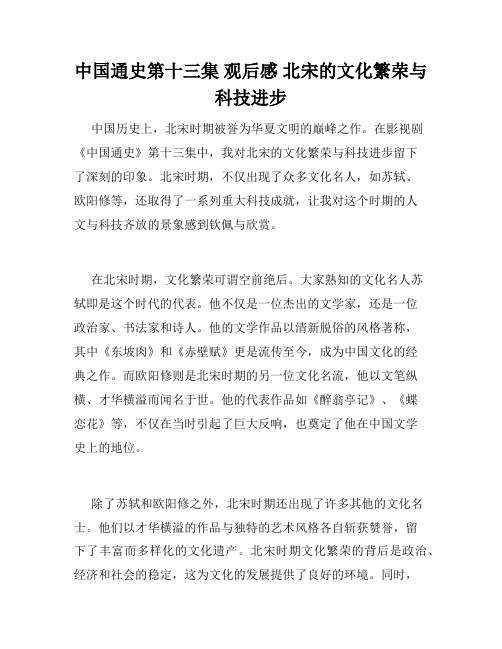
中国通史第十三集观后感北宋的文化繁荣与科技进步中国历史上,北宋时期被誉为华夏文明的巅峰之作。
在影视剧《中国通史》第十三集中,我对北宋的文化繁荣与科技进步留下了深刻的印象。
北宋时期,不仅出现了众多文化名人,如苏轼、欧阳修等,还取得了一系列重大科技成就,让我对这个时期的人文与科技齐放的景象感到钦佩与欣赏。
在北宋时期,文化繁荣可谓空前绝后。
大家熟知的文化名人苏轼即是这个时代的代表。
他不仅是一位杰出的文学家,还是一位政治家、书法家和诗人。
他的文学作品以清新脱俗的风格著称,其中《东坡肉》和《赤壁赋》更是流传至今,成为中国文化的经典之作。
而欧阳修则是北宋时期的另一位文化名流,他以文笔纵横、才华横溢而闻名于世。
他的代表作品如《醉翁亭记》、《蝶恋花》等,不仅在当时引起了巨大反响,也奠定了他在中国文学史上的地位。
除了苏轼和欧阳修之外,北宋时期还出现了许多其他的文化名士。
他们以才华横溢的作品与独特的艺术风格各自斩获赞誉,留下了丰富而多样化的文化遗产。
北宋时期文化繁荣的背后是政治、经济和社会的稳定,这为文化的发展提供了良好的环境。
同时,北宋政府也非常重视文化教育,在社会各个层面推崇儒家文化,这也为文人的诞生与发展提供了广阔的空间,使得北宋成为了文人荟萃的时代。
除了文化繁荣,北宋时期也取得了许多重大的科技进步。
在《中国通史》第十三集中,我对北宋的水利工程特别留下了深刻印象。
北宋时期,通过修建大规模的水利工程,有效地解决了江南地区的水患问题,保障了农业的发展。
其中,黄河的治理尤为引人注目,通过修筑堤坝、修复河道等措施,大大减少了黄河的泛滥,维护了人民的生命财产安全。
同时,北宋时期还出现了许多著名的水利工程,如杭州的西湖、安徽的常州、苏州的东堤等,这些工程不仅美化了环境,也提升了人民的生活质量。
除了水利工程,北宋时期还有其他众多的科技成就。
在农业方面,北宋人发明了“环耕法”、“链式耕作法”等先进的耕作技术,提高了农作物的产量。
小学历史第十三册教学解析

小学历史第十三册教学解析第一章:中国古代科技与文化的交往本章主要介绍了中国古代科技与文化的交往。
古代中国在农业、手工业、冶金、造船、纺织业等方面创造了许多技术发明,同时也吸收了外来文化的精华,对外交流活跃。
本章分为两个部分,分别是中国古代的科技与文化以及中国与世界的交流。
第一节:中国古代的科技与文化古代中国在科技与文化方面有着丰富的积累。
首先,农业方面,中国人发明了水稻的种植和养蚕技术,提高了农作物的产量和农民的生活水平。
其次,手工业方面,中国人发明了陶器、丝绸、造纸等技术,使得手工业得到迅速发展,推动了社会的进步。
此外,中国还发明了火药和指南针等重要科技,对世界的科技发展产生了重要影响。
第二节:中国与世界的交流中国古代与世界的交流主要体现在两个方面,即海上丝绸之路和陆上丝绸之路。
在海上丝绸之路方面,中国的瓷器、丝绸等商品通过海上贸易被运往东南亚、印度等地,与当地的商品进行交换。
在陆上丝绸之路方面,中国的丝绸、茶叶、香料等商品通过陆路贸易被运往中亚、西亚、欧洲等地,推动了文化的交流和经济的繁荣。
第二章:中国的四大发明本章主要介绍了中国古代的四大发明:造纸术、印刷术、指南针和火药。
这四项发明对于世界科技和文化的发展产生了深远的影响。
本章从造纸术开始,一步一步地介绍了这四项发明的历史背景、发明者、原理和影响。
第一节:造纸术在古代,中国人发明了造纸术,掌握了纸张的制作技术,使得纸张的产量大幅度增加,价格降低,极大地方便了人们的书写和交流。
造纸术对于人类文明的发展起到了重要的推动作用。
第二节:印刷术在古代,中国人发明了活字印刷术,使得书籍的复制速度大大加快,降低了书籍的价格,促进了知识的传播。
印刷术的出现是人类文明史上的一大进步,为世界书籍的广泛流传奠定了基础。
第三节:指南针在古代,中国人发明了指南针,用于辨别方向。
指南针的出现使得航海活动更加安全和准确,推动了世界各地的贸易和科学研究。
第四节:火药在古代,中国人发明了火药,用于战争和烟花爆竹。
钱穆先生全集中华文化十二讲
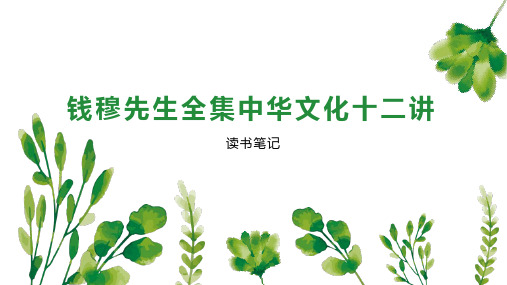
在第五讲中,钱穆先生详细介绍了中国历史上的文学。他指出,中国历史上 的文学主要有三个阶段:古典文学、骈文和散文。古典文学以《诗经》、《楚辞》 为代表,骈文以《昭明文选》为代表,散文以《古文辞类纂》为代表。
以上仅是《钱穆先生全集中华文化十二讲》的部分精彩摘录,这本书的内容 丰富深广,对于了解中国文化具有很高的价值。
阅读感受
读完《钱穆先生全集中华文化十二讲》,我深感中国传统文化的博大精深, 也更深入地理解了中国文化的中心思想——性道合一论。性道合一论,即人的本 性与大道的融合,是东方文化尤其是中国文化的一种独特理念。
在书中,钱穆先生对“道理”与“道术”进行了区分。在西方文化中,科学 和自然被视为至高无上的价值,而在东方文化中,尤其是中国文化中,人的关系 被视为同样重要的因素。这种重视人的关系的思想,体现在“道理”与“道术” 的名称中。在中国文化中,“道理”指的是人与人之间的和谐关系,“道术”则 是指维护这种和谐关系的手段。
《钱穆先生全集中华文化十二讲》是一本深入浅出地阐述中国文化的书籍, 它让我更深入地理解了中国文化的中心思想——性道合一论。通过阅读这本书, 我不仅对中国传统文化有了更深入的了解,也对自己的价值观和人生观有了更深 刻的认识。
目录分析
《钱穆先生全集中华文化十二讲》是一本深入探讨中华文化的著作,作者钱 穆以其深厚的学识和独特的视角,对中华文化进行了全面的解读。这本书的目录 更是精炼地概括了全书的主题和内容,下面我们来一起分析一下这本书的目录。
钱穆先生全集中华文化十二讲
读书笔记
01 思维导图
03 精彩摘录 05 目录分析
目录
02 内容摘要 04 阅读感受 06 作者简介
思维导图
本书关键字分析思维导图
穆先生
中国通史第十三集观后感北宋的文化繁荣与科技进步

中国通史第十三集观后感北宋的文化繁荣与科技进步中国通史第十三集观后感:北宋的文化繁荣与科技进步北宋是中国历史上一个辉煌的时期,其文化繁荣和科技进步令人叹为观止。
观看《中国通史》第十三集,我深深感受到了北宋时期的独特魅力和卓越成就。
在这一集中,我了解到北宋时期文化繁荣达到了前所未有的高峰。
首先,北宋时期文人墨客荟萃,著名的文化中心如东京(今北京)、汴京(今开封)等地涌现出了许多杰出的文化名人。
他们以诗词、对联、书法、绘画等艺术形式表达自己的情感和思想,为整个北宋社会注入了一股强大的文化力量。
例如,文学家苏轼以其豪放洒脱的文风而闻名于世,他的诗词作品如《赤壁怀古》、《临江仙·滚滚长江东逝水》等至今仍被广泛传诵。
此外,北宋时期还出现了以欧阳修、苏洵、王安石等为代表的新文化运动,提倡“经世致用”的文化价值观,对后世产生了深远的影响。
除了文化繁荣外,北宋时期的科技进步也给我留下深刻印象。
观看影片中关于北宋时期科技成就的描写,我不禁为那些杰出的科学家和发明家们的智慧和勤奋而感叹。
北宋时期的科技进步体现在多个领域,其中最为突出的就是农业、纺织业、造船业和军事技术。
北宋时期的农业技术革新,如水利工程的发展和种植技术的改进,大大提高了农业生产效率,推动了农业经济的繁荣。
此外,北宋时期的纺织业技术也达到了一个新的高度,丝绸、棉纺织品等产品出口蓬勃发展,大大推动了社会经济的发展。
在造船业方面,北宋时期的船舶制造水平达到了亚洲领先水平,成为当时世界上最发达的海洋国家之一。
在军事技术领域,北宋时期的火器技术取得了重大突破,火炮的使用大大提高了战斗力,对未来军事技术的发展起到了积极的推动作用。
通过观看《中国通史》第十三集,我深刻认识到北宋的文化繁荣和科技进步对中国和世界的影响。
北宋时期的繁荣与进步不仅改变了中国的社会风貌,也对后世产生了深远的影响。
北宋的文化繁荣使中国文化达到了一个新的高度,为后世文化的发展打下了坚实的基础。
中国通史第十三集观后感北宋的外交与国际关系

中国通史第十三集观后感北宋的外交与国际关系中国通史第十三集观后感:北宋的外交与国际关系北宋是中国历史上非常重要的一个时期,其外交与国际关系对于该时期的发展产生了深远的影响。
在观看中国通史第十三集之后,我深深地感受到了北宋外交的复杂性和其对国家的战略意义。
一、外患与北宋的应对北宋时期,中国面临来自辽国和西夏的两个强大的外部势力。
辽国作为北方的强国,与北宋的关系一直紧张。
但北宋采取了以和为贵的外交政策,通过婚姻联姻和贸易交流与辽国保持着表面的友好关系,尽量避免大规模战争的爆发。
在与西夏的关系上,北宋则采取了较为强硬的态度。
西夏以侵略北宋为目标,多次出兵南下,威胁到北宋的安全。
北宋不仅采取了军事手段来回击,同时也通过与辽国外交的协助来分化西夏与辽国的关系,避免两国联手对北宋产生更大的威胁。
二、以文治国的战略北宋采取了以文治国的战略,注重通过外交手段来解决国家间的争端。
北宋时期,中国是亚洲最强大的国家之一,以其经济与文化的繁荣而闻名于世。
这也是北宋能够在外交上保持一定主动权和地位的重要原因。
北宋通过派遣使臣、交换文书和礼物等方式,与其他国家进行了广泛的外交往来。
丝绸之路和海上丝绸之路的开通,使得北宋能够与中亚国家和南海地区的国家进行贸易往来,进一步扩大了北宋的影响力和国际地位。
三、北宋外交的成就与影响北宋的外交政策取得了一定的成就。
通过与辽国和西夏的纷争,北宋成功地确保了自身的安全,并最终将西夏的威胁压制在一定范围内。
北宋还通过与金朝的外交手段,成功地使金朝保持一定的友好态度,避免了一场覆灭性的战争。
这为北宋的存续提供了宝贵的时间和空间。
同时,北宋也在外交领域取得了一定的文化成就。
如与南宋的合作,共同推动了科技、文化的发展,对中国历史产生了深远的影响。
总之,北宋时期的外交与国际关系对于该时期中国的政治、经济和文化发展产生了重要影响。
北宋采取以和为贵的外交政策,注重文治国家战略,通过外交手段处理国家间的争端,取得了一定的成就。
中国文化通览
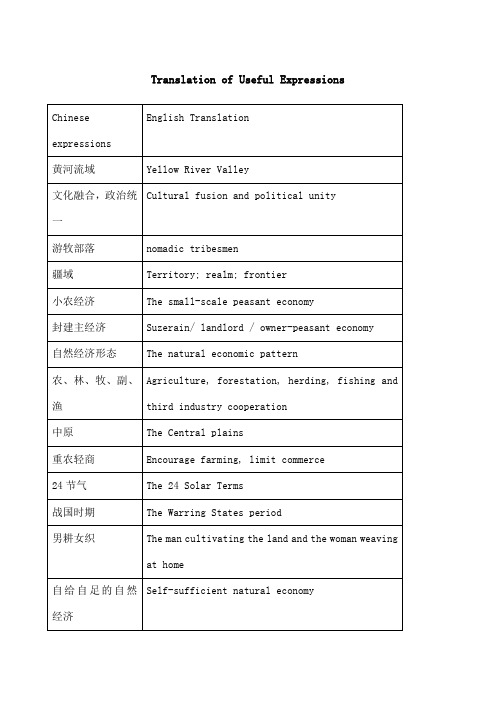
Translation of Useful Expressions ChineseexpressionsEnglish Translation黄河流域Yellow River Valley文化融合,政治统一Cultural fusion and political unity游牧部落nomadic tribesmen疆域Territory; realm; frontier小农经济The small-scale peasant economy封建主经济Suzerain/ landlord / owner-peasant economy 自然经济形态The natural economic pattern农、林、牧、副、渔Agriculture, forestation, herding, fishing and third industry cooperation中原The Central plains重农轻商Encourage farming, limit commerce24节气The 24 Solar Terms战国时期The Warring States period男耕女织The man cultivating the land and the woman weavingat home自给自足的自然经济Self-sufficient natural economy一盘散沙 A sheet of loose sand 草根阶层The grass-roots level 人头税The poll tax水能载舟,亦能覆舟The water that carries the boat can also overturn it.多元一体Integrated pluralism吐故纳新Discard the old and embrace the new炎黄子孙the descendants of Yandi and Huangdi礼仪之邦The land of ceremony and propriety大一统观念The conception of great national unity甲骨文The inscriptions on tortoise shells or animalbones铭文The inscriptions on bronze or copper wares象形、指事、会意、形声(examples)Pictographs, self-explanatory, associative compounds, pictophonetic method四书五经The Four Books and The Five Classics书同文、行同伦The standardized written language and behaviors 儒、道、佛、法家Confucianism, Classical Taoist thinking,Buddhism, the Legalist School焚书坑儒Burn books and bury Confucian scholars alive无为而治To govern by doing nothing独尊儒术、罢黜百Pay supreme tribute to Confucianism while banning家all other schools of thoughts四大发明Four Great Inventions of Ancient China:1)the invention of paper making technology2)the art of printing3)the making of the gunpowder4)the compass守内虚外Internal defense and external slackening重文轻武Lay stress on the cultural achievement while makelight of the military exploits清明上河图The scroll of painting: the festival of PureBrightness on the RiverEnglish TranslationChineseexpressions求和谐,主平衡Seek for Harmony and Maintaining Equilibrium消灾祈福Avert calamities and pray for blessings临时抱佛脚Clasp Buddha’s feet when in trouble—seek helpat the last moment六合The six realms of Heaven and Earth, East and West,North and South内圣外王Internalized as cultivation and externalized asgovernance of virtue真诚、正心、修身Sincerity, integrity and intellectualcultivation齐家治国平天下Keep your family in order, govern the stateeffectively and bring peace to the world中庸The golden mean天人合一Oneness of man and nature大一统Great National Unity集体利益Values of Collectivism/ Collective interest人伦Human relations普天之下莫非王土,率土之滨莫非王臣All the land under the sun belongs to the king; all the people within this country are the king’s subjects.《史记》The Historical Records宗族关系The patriarchal relations赴汤蹈火Go through fire and water中华民族的脊梁The spiritual tower of Chinese nation否极泰来Out of depth of misfortune comes bliss以柔克刚Conquer the rigid with the gentle一张一弛Alternate tension with relaxation仁者爱人The benevolent love others仁政Benevolent government以民为本People are the foundation of the state民为贵,社稷次People come first, the state comes second and the之,君为轻king third性善论The theory of original goodness of human nature小国寡民 A small state with a small population无为而治The rule of inaction汉代经学Imperial Confucianism in the Han Dynasty课堂重点1) The Four Books (The Great Learning , The Doctrine of the Mean , The Confucian Analects , and The Works of Mencius ) and The Five Classics (The Book of Poetry , The Book of History , The Book of Rites , The Book of Changes , and The Spring and Autumn Annals ) cover a wide range of subjects and are the most important textbooks for the Confucian scholars to disseminate the educational thoughts of the Confucian School and a must for ancient scholars who had to pass the imperial competitive examination to become government officials.2) The Great Learning is about the cultivation of one’s moral character and the wisdoms of governing a country during the “daxue” (or great learning or higher education) period of ancient China.3) The Confucian Analects or The Analects embodies the Confucian concept of ren or humanity or benevolence, and another concept of yi or righteousness.4) The Works of Mencius embodies the philosophical and political thinking of Mencius. He developed and enriched the “ren and yi theory” of Confucius and supposed that every man is good by nature, and called for a benevolent government.5) The Book of History is an incomplete collection of the history of ancient China. It is an invaluable reference for the study of the primitive and feudal societies in ancient China and is the source of narrative writing in China as well. This book consists of three parts:the exhortations, oaths or declarations by the lords to their subjects; the advice or suggestions of the subjects to their lord; folklores or other materials6) The Spring and Autumn Annals is a canonical book of history. It consists of three Commentaries: the Commentary of Zuo focuses on history; the Commentaries of Gongyang and Guliang concentrate on comments on historical events.7) Beijing Opera emerged in Qing Dynasty, when Kun opera was gradually on the wane because it was only enjoyed by the nobles in the royal court, not the general public. It is a treasure of the Chinese nation as well as a cultural symbol of China, and is enjoyed by a large Chinese audience.8) Classification of Beijing Opera9)Figure painting is the earliest kind of traditional Chinese painting; It reflects to a great degree aesthetic and artistic thinking of Confucian scholars, with the aim to rectify one’s mind and make people abstain from their desires. It is divided into five major categories: gongbi (detailed brushwork), jianbi (sketchy brushwork), xieyi (free hand brushwork), baimiao (outline drawing), and pomo (splash-ink).10) Traditional Chinese landscape painting embodies the Chinese people’s conception of nature, their aesthetic awareness, and their wisdom and sentiment. It is a unique tradition of Chinese landscape painting to create artistic conception( viz. to seek a unity of form and spirit, of human feelings and natural settings, with an emphasis on the expression of the painter’s own thoughts and feelings).11) Calligraphy is native to China; it is a traditional art with a long history and national characteristic features. It has five major scripts, namely the Seal Character, Official Script, Regular Script, Running Script, and Cursive Script 12) Four Great Masters of the Regular Script are Ouyang Xun, Yan Zhenqing, Liu Gongquan (of the Tang Dynasty) and Zhao Mengfu (of the Yuan Dynasty )3. Translate the following Chinese paragraph into English:京剧唱腔悠扬委婉,声情并茂;京剧念白简洁生动,韵律性和节奏感很强;京剧乐队的演奏旋律优美,曲调动听;京剧舞台美术绚丽多彩;京剧脸谱极富民族特色。
(最新整理)文化通览13

(完整)中国文化通览13编辑整理:尊敬的读者朋友们:这里是精品文档编辑中心,本文档内容是由我和我的同事精心编辑整理后发布的,发布之前我们对文中内容进行仔细校对,但是难免会有疏漏的地方,但是任然希望((完整)中国文化通览13)的内容能够给您的工作和学习带来便利。
同时也真诚的希望收到您的建议和反馈,这将是我们进步的源泉,前进的动力。
本文可编辑可修改,如果觉得对您有帮助请收藏以便随时查阅,最后祝您生活愉快业绩进步,以下为(完整)中国文化通览13的全部内容。
第一节饮食文化中国烹饪中国的饮食调制方法自古就有繁琐、复杂的特点。
例如,尚秉和《历代社会风俗事物考》中介绍了《礼记·内则》中记载的“炮豚”法,“炮”是中国古代的一种饮食调制方法,从中便可略见一斑:先取豚若羊杀之,实枣于腹内;再裹之以苇,涂之以泥,炮之使干,擘而摩去其油膜;再以稻米粉为糊,糊豚四周,煎于油镬中,使干,置小鼎中;再将小鼎置大镬沸汤中,汤勿灭鼎(勿使水浸入小鼎,败肉味也)。
煮三日三夜,而后调醯醢食之。
正是在这样的传统下,适应各地不同的特产、口味,便逐渐出现了各种不同的调制方法。
后来,在长期的实践过程中,又逐渐形成了各种具有地方特色的饮食体系。
比如鲁菜(山东菜)、京菜(北京菜)、沪菜(上海菜)、苏菜(江苏菜)、浙菜(浙江菜)、川菜(四川菜)、徽菜(安徽菜)、粤菜(广东菜)、湘菜(湖南菜)、鄂菜(湖北菜)、闽菜(福建菜)、陕菜(陕西菜)、东北菜(东北地区菜肴的总称)、豫菜(河南菜),以及仿膳菜(仿制的宫廷菜)、清真菜(回族菜的总称)、素菜(由佛教寺院所创、由僧厨执鼎、以非动物原料烹制的菜肴)等。
各个菜系或清雅或淳厚、或麻辣或酸甜,不仅各有自己的独到之处,而且还各有自己的拿手好菜。
比如闽菜中的“佛跳墙”,原名“全福寿”,用海参、广肚、干贝、鱼翅、火腿、蹄筋、香菇、鸽子蛋、鸡鸭等10余种名贵原料,置于坛中,再加骨汤、绍酒、香料等,以荷叶封口,密封坛内,用文火煨制而成。
东西方文化里的“十三”-word文档资料

东西方文化里的“十三”东西方文化里的“十三”王连龙“十三”本是数字世界中极为普通的一员,但由于东西方文化背景和传统方面的差异,它受到了不同的对待。
以中国为代表的东方文化,对“十三”爱有所偏。
中国的古人把儒家的《诗》、《书》等十三部著作总称为《十三经》,宋代有人把为《十三经》所作的注释合并刊刻,成为流传后世的《十三经注疏》。
明、清时期,我国北方的说唱文学中通行着“十三辙”,以此来规范押韵的韵脚,现在戏剧、曲艺等说唱艺术中还在使用它。
明清时的音乐里有以弦乐为主的合奏曲集《弦索十三套》。
古老的军事著作《孙子兵法》历遭劫难,残存的篇数恰好为“十三”。
在官衙的分设上,汉代武帝时曾设有十三刺史部,元明时有十三布政司,清顺治年间设有十三衙门。
我国的建筑也离不了“十三”,杭州的六和塔、西藏的布达拉宫都采用了十三层的建筑结构。
连街道的命名也没少“十三”,广州市文化公园后面的一条街道,就叫“十三行”。
而我国少数民族怒族所崇信的四类鬼神的总数也恰好是“十三”。
人们还喜欢用“十三太保”“十三科”等词语来概述一类事物的整体。
东方文化对“十三”的偏爱由此可见一斑。
但“十三”也有不讨中国人喜欢的时候,被人称为“十三点”(本意为时钟不准,现多用以指人不聪明),恐怕谁也不见得高兴。
与中国人对“十三”的态度相反,西方人将“十三”视为不祥之数,凡事不愿与“十三”挂钩。
究其原因,最流行的解释认为,耶稣在与门徒共进晚餐时,被第十三个门徒尤大出卖而殉难,从此“十三”便与叛徒尤大结下了不解之缘。
今天,欧美国家航空公司的飞机座舱里几乎都没有“13”排座,旅馆也没有“13”号客房,楼房亦没有13层。
城市的门牌号码、宴会的餐桌也都避开“13”,或以“12B”代替,或者干脆跳过去。
作曲家为作品编号,也很难找到“13号”。
或许有人注意到,忌讳“13”的西方人,似乎也没有禁绝“13”的意思,娱乐活动使用的扑克牌,4种花色牌均为13张,老外们照玩不误。
倒是我国北方某城市一家名闻中外的旅行社,却随了洋人去忌讳“十三”,出售的游览图上,居然将“十三陵”印成了“十二陵”,一时被传为奇闻。
- 1、下载文档前请自行甄别文档内容的完整性,平台不提供额外的编辑、内容补充、找答案等附加服务。
- 2、"仅部分预览"的文档,不可在线预览部分如存在完整性等问题,可反馈申请退款(可完整预览的文档不适用该条件!)。
- 3、如文档侵犯您的权益,请联系客服反馈,我们会尽快为您处理(人工客服工作时间:9:00-18:30)。
第一节饮食文化中国烹饪中国的饮食调制方法自古就有繁琐、复杂的特点。
例如,尚秉和《历代社会风俗事物考》中介绍了《礼记·内则》中记载的“炮豚”法,“炮”是中国古代的一种饮食调制方法,从中便可略见一斑:先取豚若羊杀之,实枣于腹内;再裹之以苇,涂之以泥,炮之使干,擘而摩去其油膜;再以稻米粉为糊,糊豚四周,煎于油镬中,使干,置小鼎中;再将小鼎置大镬沸汤中,汤勿灭鼎(勿使水浸入小鼎,败肉味也)。
煮三日三夜,而后调醯醢食之。
正是在这样的传统下,适应各地不同的特产、口味,便逐渐出现了各种不同的调制方法。
后来,在长期的实践过程中,又逐渐形成了各种具有地方特色的饮食体系。
比如鲁菜(山东菜)、京菜(北京菜)、沪菜(上海菜)、苏菜(江苏菜)、浙菜(浙江菜)、川菜(四川菜)、徽菜(安徽菜)、粤菜(广东菜)、湘菜(湖南菜)、鄂菜(湖北菜)、闽菜(福建菜)、陕菜(陕西菜)、东北菜(东北地区菜肴的总称)、豫菜(河南菜),以及仿膳菜(仿制的宫廷菜)、清真菜(回族菜的总称)、素菜(由佛教寺院所创、由僧厨执鼎、以非动物原料烹制的菜肴)等。
各个菜系或清雅或淳厚、或麻辣或酸甜,不仅各有自己的独到之处,而且还各有自己的拿手好菜。
比如闽菜中的“佛跳墙”,原名“全福寿”,用海参、广肚、干贝、鱼翅、火腿、蹄筋、香菇、鸽子蛋、鸡鸭等10余种名贵原料,置于坛中,再加骨汤、绍酒、香料等,以荷叶封口,密封坛内,用文火煨制而成。
据说,清代福州有一家菜馆制作的“全福寿”香气四溢,竟诱使隔壁寺院的一名高僧不顾佛门戒律,跳墙而入,饱餐了一顿。
故又名“佛跳墙”。
而鲁菜中的“泰山三美”,则是用泰安的白菜、豆腐和水烹制的“白菜炖豆腐”,自然素雅,清香宜人。
中国菜肴的花色之多、菜式之众、制作之繁,是世界闻名的。
中国菜还具有浓厚的文化底蕴。
传说古代有一个名厨,只用两个鸡蛋就做出了4道“雅菜”:第一道菜,将两个鸡蛋黄煮熟放在盘子里,菜名叫“两只黄鹂鸣翠柳”;第二道菜,将一个鸡蛋清煮熟切成三角状码在盘子里,菜名叫“一行白鹭上青天”;第三道菜,将另一个鸡蛋清炒作碎末状堆在盘子里,菜名叫“窗含西岭千秋雪”;第四道菜,将4瓣蛋壳漂在一碗清汤里,菜名叫“门泊东吴万里船”。
而这4个菜名,恰好是杜甫的《绝句》。
值得一提的是,中国菜讲味道、重艺术,并不等于不重视营养。
实际上,中国菜作为一种文化,很早就与中医结下了密切的关系,在讲究味道和意味的同时,更讲究营养和保健。
比如百草脱骨扒鸡、黄芪汽锅鸡、虫草全鸭、核桃鸭子、枸杞肉丝、人参莲肉汤、当归羊肉羹、双耳汤、羊肺汤、肝片汤等等,远比大块的排骨和烤肉的营养价值要高。
Chinese Culinary ArtsChinese culinary arts are rather complicated, and in different places, there are different ways for preparing dishes. Many different cuisines unique to certain areas are formed, for instance, Shandong cuisine, Beijng cuisine, Shanghai cuisine, Sichuan cuisine, Jiangsu cuisine, Zhejiang cuisine, Anhui cuisine, Hunan cuisine, Hubei cuisine, Fujian cuisine, Shannxi cuisine, Henan cuisine, north-eastern China cuisine, royal style cuisine, Muslim style cuisine and vegetarian cuisine.Each cuisine has its own specialty. For example, the Fujian cuisine has a dish called “happiness and longevity”. Its preparation is like this: first put some of the most nutritious ingredients (sea cucumber, dried scallop, shark’s fin, ham, tendons of beef, dove’s eggs, chicken, duck, etc) into a jar, then add some bone broth, Shaoxing rice wine and spices, next, cover the mouth of the jar with a lotus leaf, and last,simmer it on the stove. It’s not hard to imagine how delicious and nutritious the dish would be. This dish has another well-known name—“Buddha jumping over the wall”. It may sound strange, but there’s an interesting story behind it. It is said that during the Qing Dynasty, a restaurant in Fuzhou (the capital city of Fujian Province) was very famous for its dishes. One day, the restaurant made the dish “happiness and longevity”, the aroma of the dish was so appetizing and spread so far that a monk in a nearby temple just couldn’t resist the temptation. In the end, he put aside the Buddhist discipline, jumped over the wall into the restaurant, and ate to his heart’s content. What happened to the monk afterwards, we do not know, but the reputation of the dish “Buddha jumping over the wall” spread afar. Generally speaking, there are three essential factors by which Chinese cooking is judged, namely: “color, aroma and taste”. “Color” refers to the layout and design of the dishes. “Aroma” implies not only the smell of the dish, but also the freshness of the materials and the blending of seasonings. “Taste” involves proper seasoning and fine slicing techniques. These three essential factors are achieved by careful coordination of a series of delicate activities: selecting ingredients, mixing flavors, timing and cooking, adjustment of the heat, and laying out the food on the plate.What is worth mentioning is that there’s a lot of cultural background knowledge involved in the naming of Chinese dishes. Often, it’s hard, even for the Chinese people themselves, to tell what is actually in a certain dish until it is served on the table. Of course, one can always turn to the waiter or waitress for explanation. In most cases, waiters and waitresses are ready to satisfy one’s curiosity.Apart from having regard for the above-mentioned three essential factors —“color, aroma and taste”, Chinese cuisine attaches great importance to nutrition. As a matter of fact, Chinese cuisine has long been closely related to traditional Chinese medicine. Ginseng, walnut, Chinese angelica and the fruit of Chinese wolfberry are often used as ingredients in certain Chinese dishes.中国筷子与其他民族一样,中国最初的食用方法也是“以手奉饭”,也就是用手抓,或用手撕,至于使用筷、叉、刀、匙等进餐用具,则都是较晚的方法。
其中,筷子是中国进餐习俗中的一绝,至今已有数千年的历史。
筷子是日常生活中经常用到的一种进餐工具,也是中国人进餐时的必备用具。
古代称为“箸”,也写作“筯”或“櫡”等,今俗称筷子。
其形或下圆上方、或上下全圆而上粗下细,其制必长短相等、粗细相类,其用必成双成对、双箸齐举。
通常以右手持筷,夹取饭菜。
